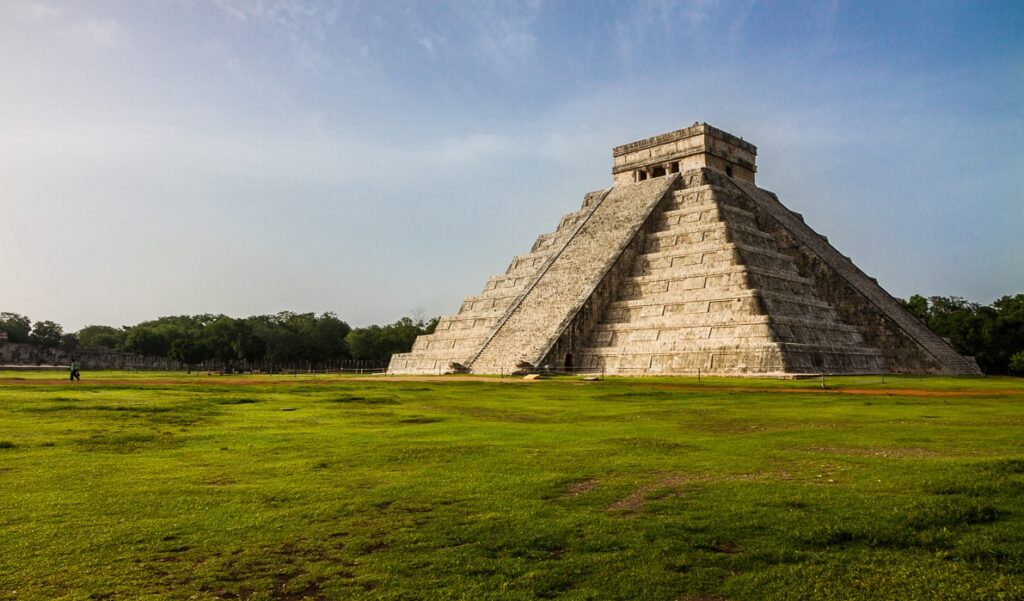ប្រវត្តិសាស្ត្រនៃអរិយធម៌ម៉ាយ៉ា គឺជាប្រធានបទមួយដែលមានការជជែកគ្នាយ៉ាងច្រើនក្នុងចំណោមអ្នកស្រាវជា្រវមួយចំនួនដូចជា ប្រវត្តិវិទូ នរវិទូ និងបុរាណវិទូជាដើម ដែលបានសិក្សាស្រាវជ្រាវពិសេសក្នុងតំបន់អាមេរិកកណ្តាល។ ដ្បិតវិសាលភាពនៃអរិយធម៌នេះ គឺមានការរីកចម្រើនខ្លាំង និងបានបន្សល់នៅស្ថានីយ៍បុរាណជាច្រើននៅតាមបណ្តាប្រទេសក្នុងតំបន់អាមេរិកកណ្តាល។
ម៉ាយ៉ា គឺជាជនជាតិដើមដែលរស់នៅក្នុងព្រៃត្រូពិកក្នុងតំបន់អាមេរិកកណ្តាល និងត្រូវបានអ្នកស្រាវជ្រាវស្គាល់ថា ម៉ាយ៉ាជាអរិយធម៌ចំណាស់ទី២ក្នុងចំណោមអរិយធម៌ មេសូអាមេរិក បន្ទាប់ពីអរិយធម៌អូលមេក។ វិសាលភាពទឹកដីនៃអរិយធម៌នេះមានការរីកចម្រើននៅតំបន់អាមេរិកកណ្តាលដែលបច្ចុប្បន្នជាប្រទេសម៉ិកស៊ិកូ ហ្គាតេម៉ាឡា បេលីហ្ស ហុងឌូរ៉ាស និងអែលសាល់វ៉ាឌ័រ។
ក្នុងប្រវត្តិសាស្រ្តនៃអរិយធម៌ម៉ាយ៉ា អ្នកស្រាវជា្រវបានបែងចែកចេញជាបីសម័យធំៗគឺសម័យ Pre-Classic, Classic និង Post-Classic។ សម័យ Pre-Classic(១០០០មុនគ.ស រហូតដល់ ឆ្នាំ២៥០នៃគ.ស. )ដែលជាសម័យកាលនៃការកកើតវប្បធម៌ និងអរិយធម៌ម៉ាយ៉ានៅក្នុងតំបន់អាមេរិកកណ្តាល។ ក្នុងសម័យកាលនោះ ប្រជាជនម៉ាយ៉ា គឺជាសង្គមដែលរស់នៅតាមបែបការបរបាញ់សត្វ ចាប់សត្វព្រៃធ្វើជាចំណីអាហារ (Hunter- gatherer)។ រីឯសម័យ Classic (ឆ្នាំ២៥០គ.ស. រហូតដល់ឆ្នាំ៩០០គ.ស.) ត្រូវបានអ្នកស្រាវជា្រវស្គាល់ថាជាសម័យនៃការរីកចម្រើនសំណង់ សិល្បៈ វប្បធម៌ និងការពង្រីកទឹកដីកាន់តែធំរហូតដល់ក្លាយជាអាណាចក្រម៉ាយ៉ា។ សម័យ Post Classic ជាសម័យកាលដែលបន្តពីសម័យ Classic រហូតដល់ដើមស.វ.ទី១៦ (១៥៣៩នៃគ.ស.) នៅពេលដែលពួកអេស្ប៉ាញបានមកដល់តំបន់អាមេរិកកណ្តាល។
ចាប់ពីតំបន់ព្រៃត្រូពិកទឹកភ្លៀងដែលស្ថិតនៅភាគពាយ័ព្យ នៃប្រទេសហ្គាតេម៉ាឡា បេលីហ្ស និងតំបន់ឈីប៉ាស នៃប្រទេសម៉ិកស៊ិកូ ដោយអ្នកស្រាវជ្រាវបានបង្ហាញថាជា តំបន់ស្នូលសំខាន់ នៃអាណាចក្រម៉ាយ៉ាក្នុងសម័យ Classic។ សម័យ Classic គឺជាសម័យកាលដែលអរិយធម៌ម៉ាយ៉ារុងរឿងខ្លាំង។ នៅអំឡុងស.វទី១៩ តាមរយៈការស្រាវជា្រវរបស់អ្នកភូមិវិទូ និងបុរាណវិទូលើទីក្រុងបុរាណរបស់អរិយធម៌ម៉ាយ៉ា បានរកឃើញទីតាំងប្រហែល៤០កន្លែង ក្នុងចំណោមនោះមាន៦ទីតាំងដែលអ្នកស្រាវជា្រវបង្ហាញថាជាទីក្រុងសំខាន់ៗនៃអាណាចក្រម៉ាយ៉ា ក្នុងនោះរួមមានដូចជានៅស្ថានីយ៍ Copan (Honduras), Calakmul (Mexico), Palenque (Mexico), Yucatán (Mexico), Quirigua (Guatemala) និង Tikal (Guatemala)។ បច្ចុប្បន្នទីតាំងទាំង៦នោះ គឺសិ្ថតនៅប្រទេសផ្សេងៗគ្នា ពោលមាននៅប្រទេសម៉ិកស៊ិកូចំនួន៣ទីតាំង ហ្គាតេម៉ាឡាចំនួន២ទីតាំង និងនៅហុងឌូរ៉ាស ចំនួន១ទីតាំង។
ការរៀបចំក្រុងនៃអរិយធម៌ម៉ាយ៉ា គឺជាការរៀបចំជាបណ្តុំនៃសំណង់ ដោយសំណង់គោលនោះ គឺជាប្រាសាទពីរ៉ាមីតដែលសម្រាប់ការគោរពដល់ព្រះក្នុងអរិយធម៌ម៉ាយ៉ាបុរាណ។ លើសពីនេះតាមរយៈសំណង់ សិល្បៈ និងស្ថាបត្យកម្ម អ្នកស្រាវជ្រាវបានដឹងថា ប្រជាជនម៉ាយ៉ាមានចំណេះដឹងខាងផ្នែក គណិតវិទ្យា តារាសាស្រ្ត ប្រតិទិន និងការរៀបចំក្រុង។ អ្នកស្រាវជ្រាវក៏បានដឹងថា នៅសម័យ Classic ការផលិតកសិកម្មគឺជាកត្តាយ៉ាងសំខាន់ក្នុងការរីកចម្រើនអរិយធម៌។
ប្រហែលនៅចុងស.វ.ទី១០ បណ្តាទីក្រុងនៃអរិយធម៌ម៉ាយ៉ាត្រូវបានបោះបង់ចោល។ នៅដើមស.វ.ទី១៦ មានការមកដល់នូវជនជាតិអេស្ប៉ាញក្នុងតំបន់អាមេរិកកណ្តាល។ អ្នកស្រាវជ្រាវពុំដឹងអំពីមូលហេតុ នៃការដួលរលំនៃអាណាចក្រម៉ាយ៉ានៅឡើយ ប៉ុន្តែប្រហែលមកពីការមកដល់នូវជនជាតិអេស្ប៉ាញពីឈ្លានពានគ្រប់គ្រង់លើអាណាចក្រម៉ាយ៉ា និង បណ្តាលមកពីការប្រែប្រួលអាកាសធាតុក្នុងតំបន់។
តាមរយៈសំណង់ស្ថាបត្យកម្ម និងសិល្បៈដែលបានបន្សល់ពីអរិយធម៌ម៉ាយ៉ា អ្នកស្រាវ-ជ្រាវបានបង្ហាញថា អរិយធម៌នៃអាណាចក្រម៉ាយ៉ាមានឥទិ្ឋពលខ្លាំងក្លា រុងរឿងជាងគេនៅតំបន់អាមេរិកកណ្តាល និងបង្ហាញថាជនជាតិម៉ាយ៉ាបានមកតាំងទីរស់នៅក្នុងអាមេរិកកណ្តាលប្រមាណជាង១៥០០ឆ្នាំមុនគ.ស. និងបានក្លាយជាអាណាចក្រម៉ាយ៉ានៅសត-វត្សទី៦នៃគ.ស.៕
——————————————————————-
Maya Civilization
The history of the Maya civilization is a hotly debated topic among some historians, anthropologists, and archaeologists who have conducted specialized research in Central America. Because the territory of this civilization is very developed and left in many ancient sites in the countries of Central America.
The Maya are indigenous people living in the tropical rainforests of Central America and are known by researchers as the second oldest civilization of the Mesoamerican civilization after the Olmec civilization. The territory of this civilization flourished in Central America which is now Mexico, Guatemala, Belize, Honduras, and El Salvador.
In the history of the Maya civilization, researchers have divided it into three major periods: the Pre-Classic, the Classic, and the Post-Classic. The Pre-Classic period (1000 BC until 250 AD) was the period of the emergence of Mayan culture and civilization in Central America. At that time, the Maya were a hunter-gatherer society. The Classic Period (250 AD to 900 AD) is known by researchers as a period of development of construction, art, culture, and expansion of the territory until it became the Maya Empire. The Post Classic period was a period that continued from the Classic period until the beginning of the 16th century (1539 AD) when the Spaniards arrived in Central America.
From the tropical rainforests of northwestern Guatemala, Belize, and the Chiapas region of Mexico, researchers have identified as the important core zone of the Maya Empire in the Classical period. The Classic period was a period in which Maya civilization flourished. During the 19th century, through the research of geologists and archaeologists on the ancient cities of the Maya civilization, about 40 sites were found, six of which were identified by researchers as major cities of the Maya Empire. These include Copan (Honduras), Calakmul (Mexico), Palenque (Mexico), Yucatán (Mexico), Quirigua (Guatemala) and Tikal (Guatemala) sites. Today, the six locations are in different countries: three in Mexico, two in Guatemala, and one in Honduras.
The city of Maya civilization is a group of constructions, with the main structure being the pyramids for worshiping gods in ancient Maya civilization. In addition, through construction, art, and architecture, researchers recognized that the Maya had knowledge of mathematics, astronomy, calendars, and urban planning. Researchers also realized that in the Classic Period, agricultural production was an important factor in the development of civilization.
Around the end of the 10th century, the cities of the Maya civilization were abandoned. At the beginning of the 16th century, there was the arrival of the Spaniards in Central America. Researchers do not yet know the cause of the fall of the Maya Empire, but probably due to the arrival of the Spaniards from the invasion of the Maya Empire and due to local climate change.
Through the architectural and artistic remains of the Maya civilization, researchers have shown that the civilization of the Maya Empire was the most influential and glorious in Central America and that the Maya people settled in Central America more than 1,500 BC and became the Maya Empire in the 6th century.
អត្ថបទដើម៖ លោក អេង តុលា












